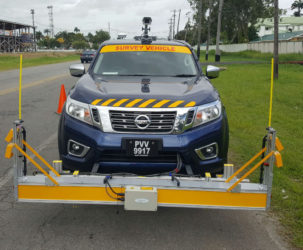The Ministry of Public Infrastructure has acquired a new computerised system that can quickly and accurately collect pavement and asset data.
According to a press release from the Ministry of Public Infrastructure, the new system, ROMDAS (Road Measurement Data Acquisition System) utilizes a number of laser sensors, a bumper integrator, GPS and a right of way camera to carry out automatic crack and defect measurements, pavement roughness measurements, mobile mapping of the road corridor and travel time and congestion surveys.
Patrick Thompson, the Ministry’s Chief Transport Planning Officer explained that the decision to introduce the system at the Ministry came in light of issues encountered over the years with the sustainability of data collection procedures, the release said.

“One of our fundamental problems in the Ministry is the absence of accessible data. The absence of reliable data often results in poor planning and decision making; data is essentially the reality of the situation in numbers,” the release quoted him as saying. “Too many times we have found ourselves estimating or guessing in the absence of reliable data; now we can make firm, irrefutable future decisions in the road sector if this technology is optimally utilised.”
The release stated that the Ministry hopes to use the ROMDAS equipment to create a geo-referenced database of Guyana’s primary and secondary road network within the next 12 months.
According to the release, 12 persons from the Ministry and one final year student from the University of Guyana undertook a 10-day training conducted by Krishna Jammalamadaka, the Director of Research and Development of ROMDAS, New Zealand. The training included the theoretical, practical and safety instructions required to optimise the use of the technology.
The ROMDAS technology is used in approximately 60 countries around the world, with four countries in Latin America currently utilizing this New Zealand developed technology.





